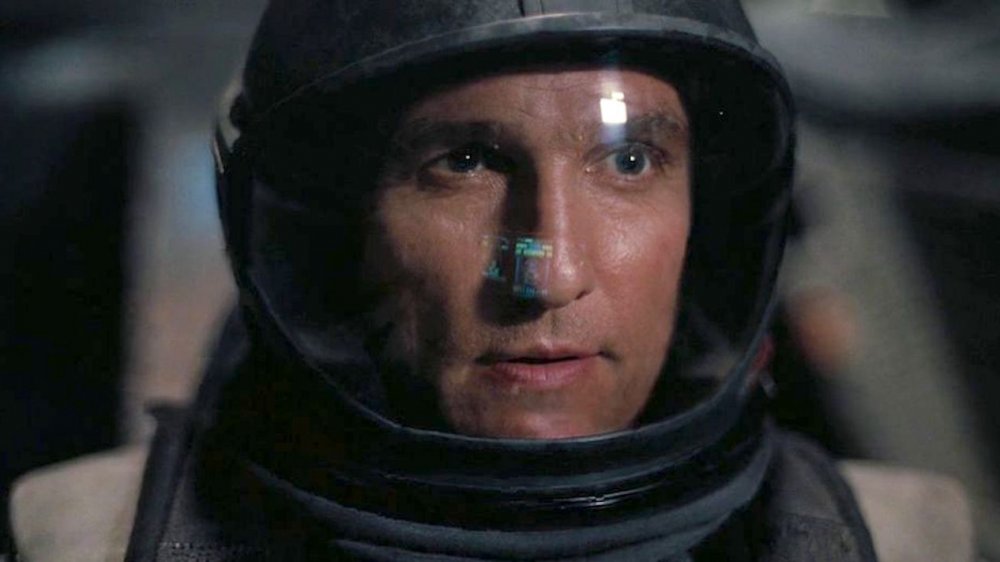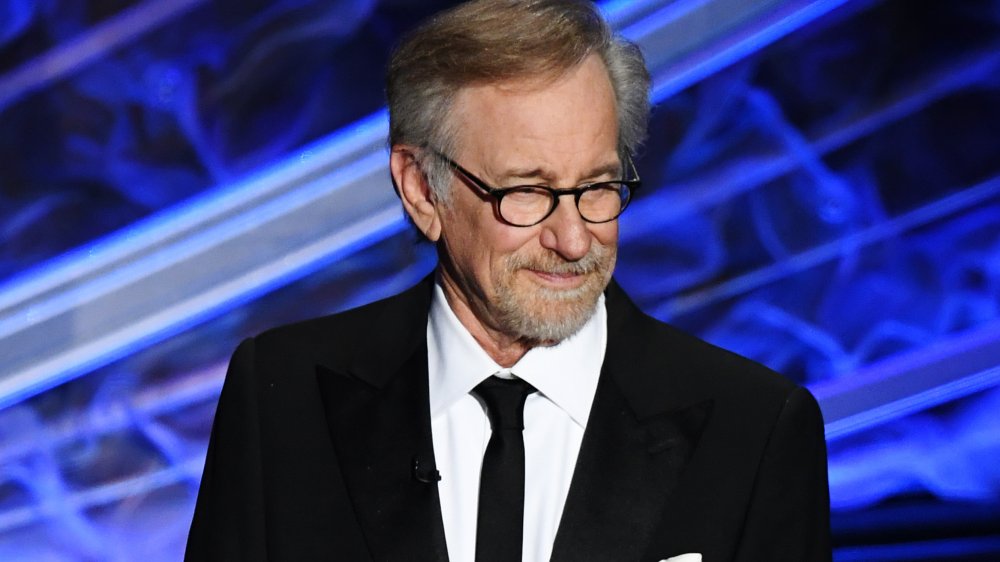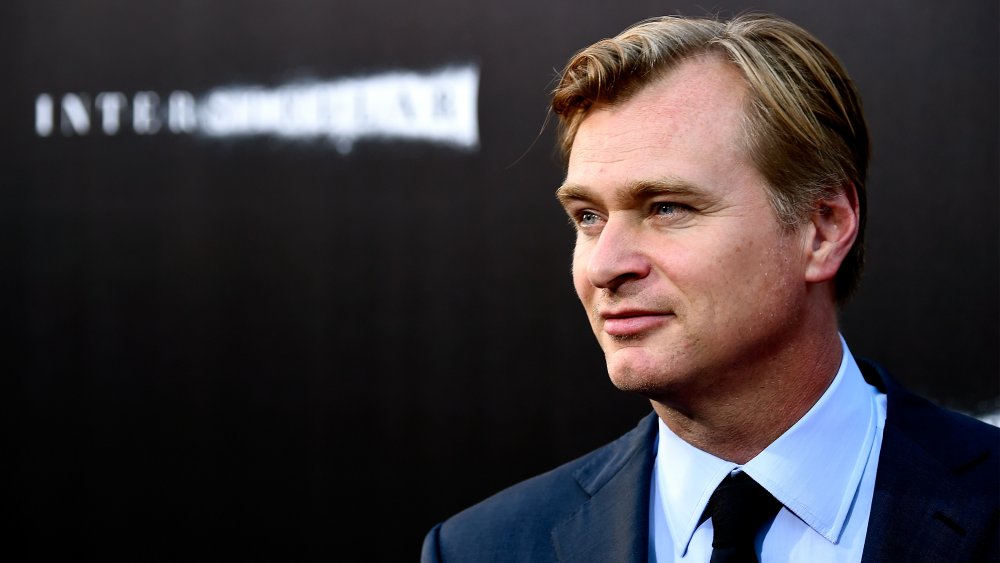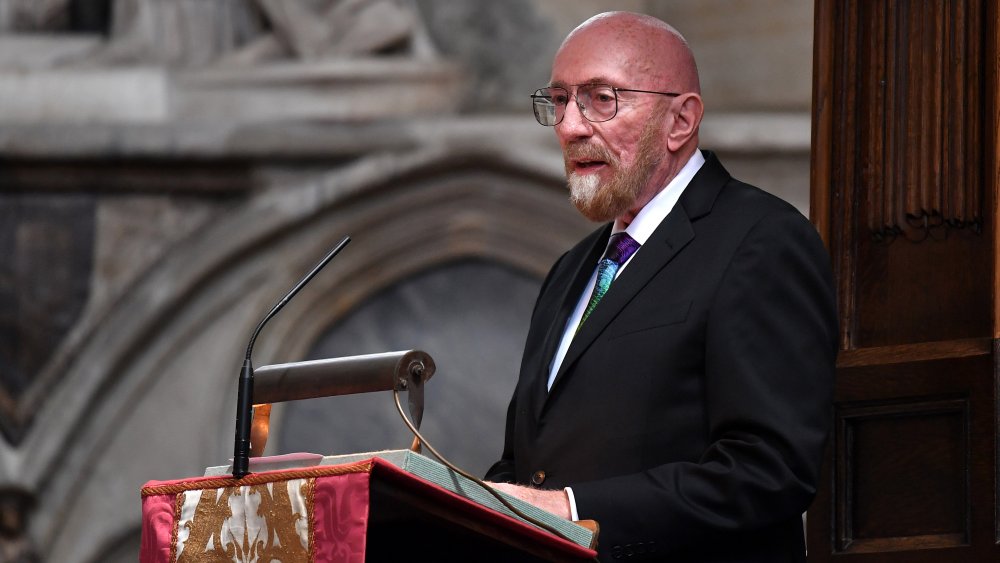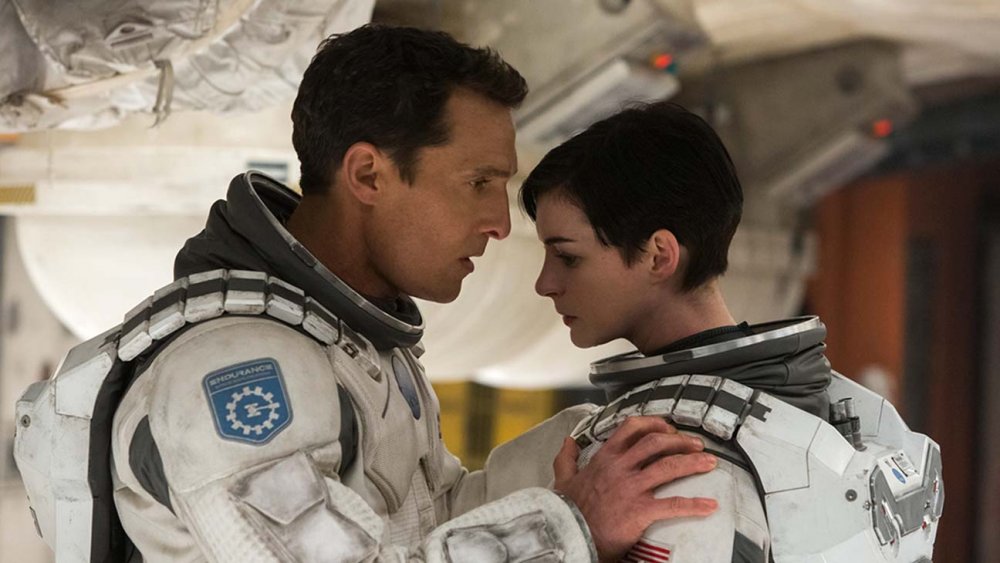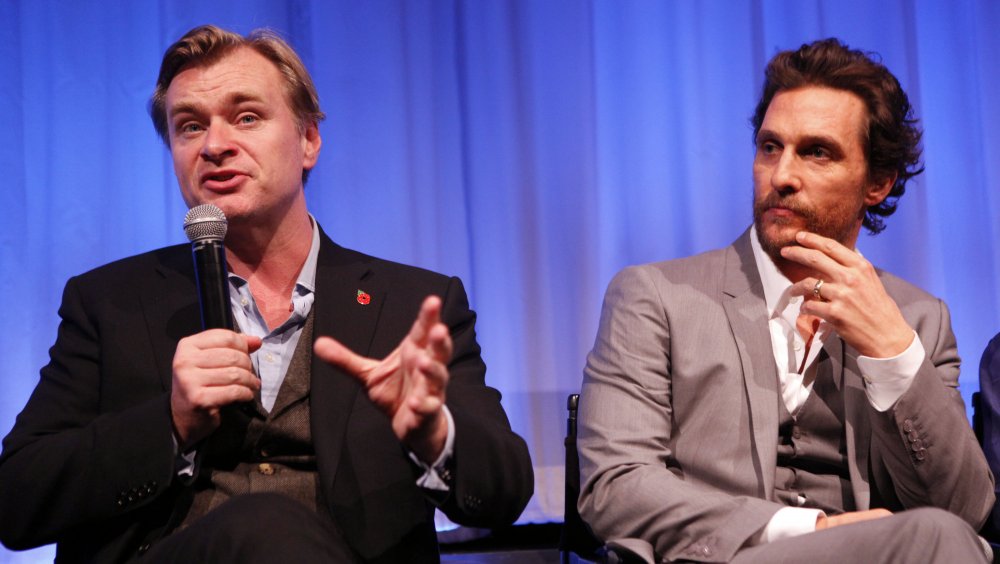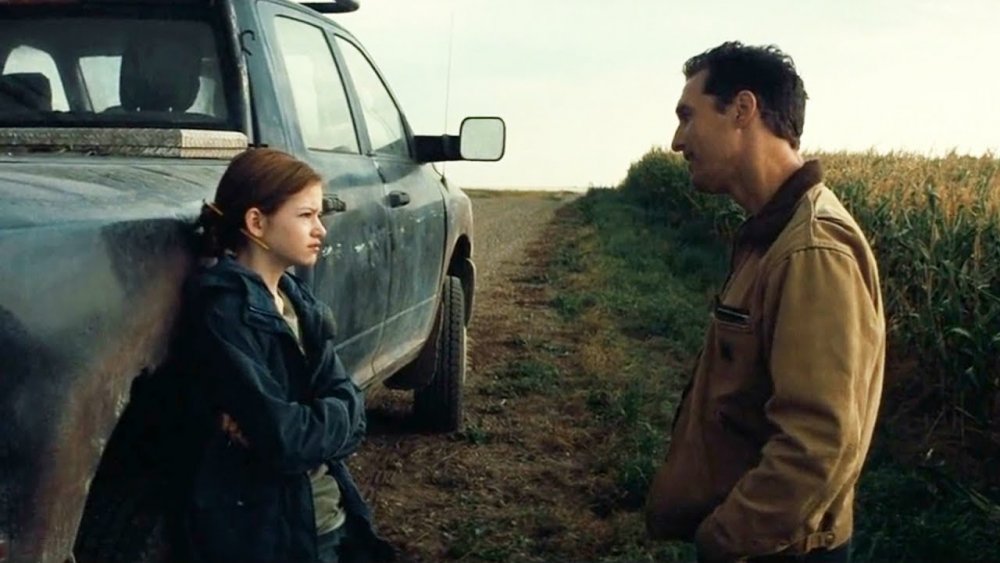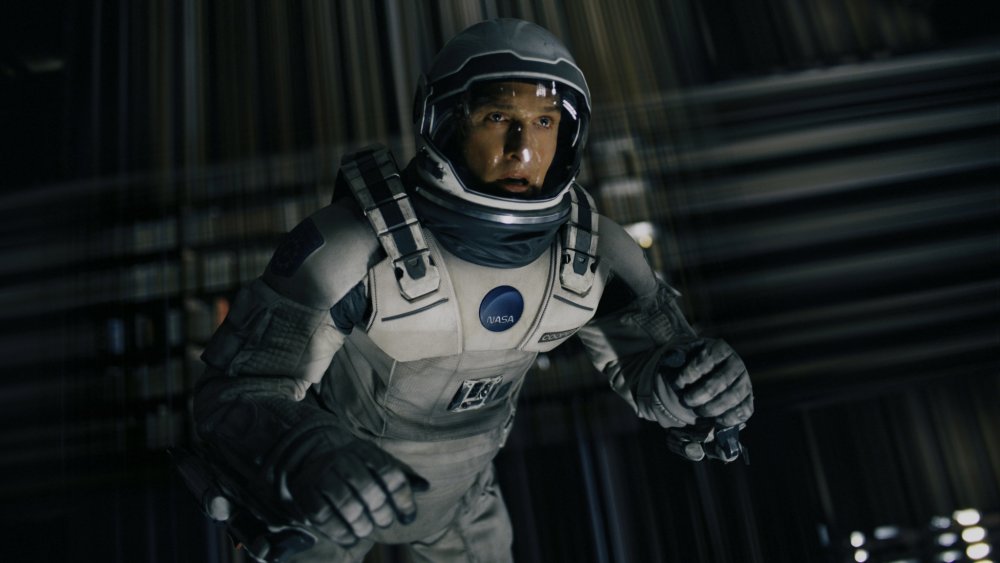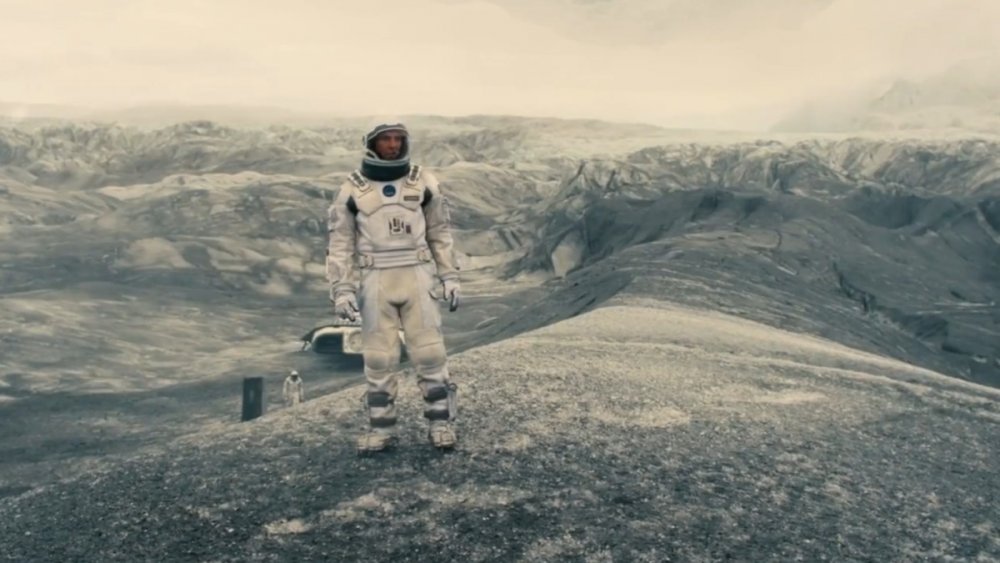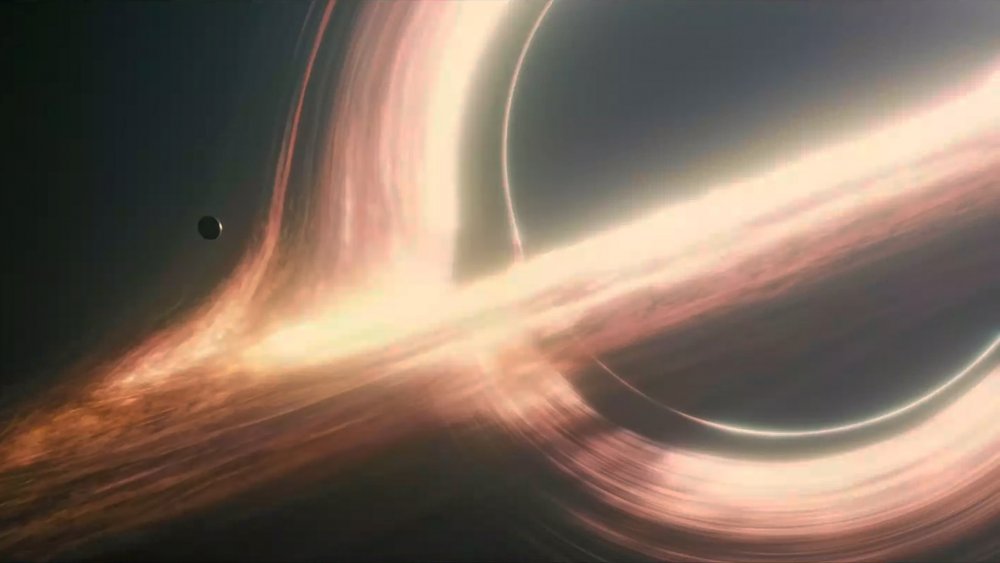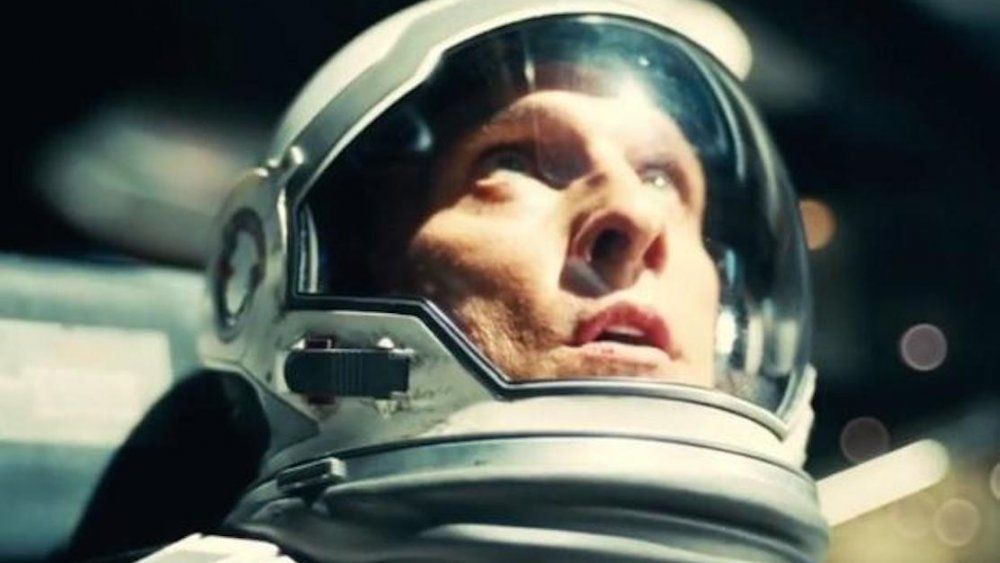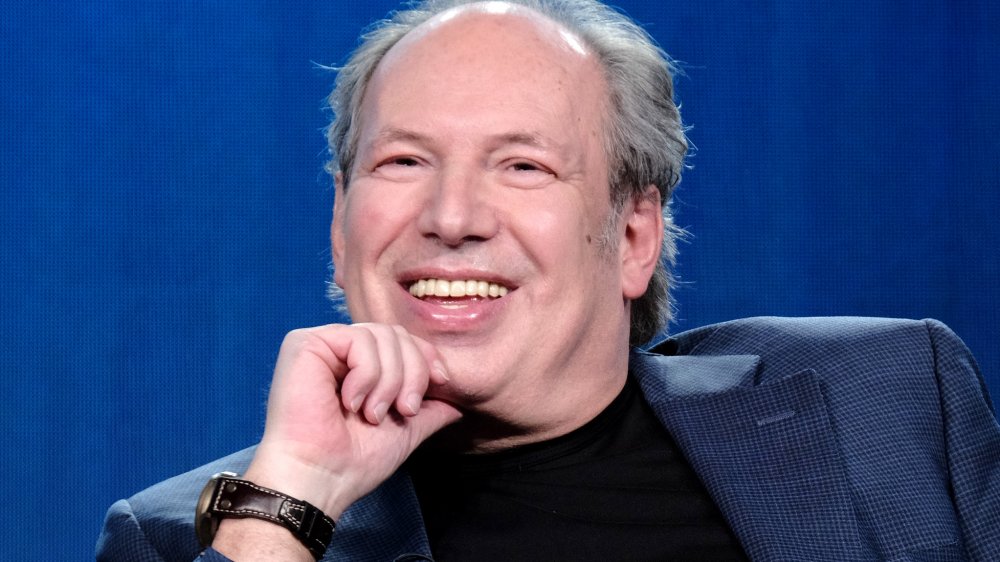The Untold Truth Of Interstellar
We may receive a commission on purchases made from links.
By the time 2014 rolled around, Christopher Nolan was a Hollywood hero to millions of movie fans who were sick of paint-by-numbers sequels and hollow, cash-grab reboots. Even the ones of his that were sequels or reboots (like his Dark Knight trilogy) were magnets for critical acclaim and enormous box office appeal. Each film was visionary and exciting. Every scene was a spectacle with narrative purpose, filmed with one on eye on tradition (practical effects and film over digital) and the other on the future (groundbreaking storytelling and visual tactics).
Interstellar, about a group of astronauts hurtling into the unknown in search of a new home for the human race, was a continuation of this legacy. Nolan set out to make a film that celebrated science rather than fiction, and so he built Interstellar's visual grandeur on established scientific principle, rather than tired genre tropes. The result was arguably the most ambitious film of the year and one of the greatest visual spectacles of all time. As was the case in previous films, Nolan relied on IMAX cameras and practical effects to bring the movie to life, and he pushed his team to produce the best possible work. However, there's far more to this story than space ships, black holes, and mysterious libraries. From the film's original director to real-life discoveries, here's the untold story of Interstellar.
Steven Spielberg was originally going to direct Interstellar
Interstellar wasn't exactly in what's known as production hell, since interest in making the film always remained high (production purgatory, maybe?). However, the script had spent the better part of a decade getting bumped around Hollywood before screenwriter Jonathan Nolan suggested his brother (and the film's occasional co-screenwriter), Christopher, should helm the project. Before that, the movie was the passion project of Steven Spielberg, who'd been inspired by a presentation on wormholes by Caltech's Kip Thorne, and he planned to tackle the film after 2012's Lincoln. Sadly, Spielberg was forced to depart the project in 2007 after he failed to make a deal with Paramount, the studio behind Interstellar. Enter Chris Nolan, and the rest is Hollywood history.
Interestingly, the original draft of the script is a far, far cry from the one we actually got (via Slashfilm). Sure, there are plenty of similarities, such as Cooper (Matthew McConaughey) flying through a worm hole in search of a new home for mankind. However, Murph (played by Mackenzie Foy and Jessica Chastain) is a boy, and a fallen space probe brings Cooper to NASA as opposed to the gravity bookshelf ghost in Murph's bedroom. Stranger still, the Lazarus missions preceding Cooper's trips through the wormhole never happened, our heroes find a Chinese base on the ice planet (which is the only planet they visit in this version), and Matt Damon's character is replaced by aliens, killer robots, and gravity machines.
Christopher Nolan always dreamed of helming a sci-fi epic
At CinemaCon 2014, Christopher Nolan said in a Q&A session, "For me, [Interstellar is] about harking back to films I saw when I was a child." He's frequently cited 2001: A Space Odyssey in particular as being profoundly influential on his career. He and his Interstellar crew also watched Philip Kaufman's 1983 space epic The Right Stuff, with Nolan saying to Empire (via IGN) that "it's an almost perfectly made film" and one that "not enough people have seen on the big screen." Nolan also cited Steven Spielberg's Close Encounters of the Third Kind and Jaws as "having a great spirit" that he "really wanted to try and capture."
But for Nolan, Interstellar wasn't just about paying homage to his favorite movies as a kid. He wanted to inspire the audience to fall in love with space travel again and encourage them to support continued public investment in the sciences by making a film celebrating that very thing (instead of genre tropes like little green men and photon blasters). "I grew up in a time when to be an astronaut was the highest ambition of any child," he said while discussing the film at Comic-Con in 2014. "I felt that had fallen off greatly over the last couple of decades."
Kip Thorne lent a big hand (and a bigger mind) to Interstellar
Kip Thorne, a Caltech physicist who'd collaborated on 1997's Contact and who'd long since wanted to make a film about time travel and wormholes, was attached to Interstellar from its inception. When Chris Nolan was hired to direct, Thorne made him promise two things — nothing in the film could violate known laws of physics, and anything speculative featured in the movie would come from a scientist, not a screenwriter. Nolan agreed on both counts.
However, in an interview with Scientific American, Thorne — who was both a consultant and executive producer on the film — describes having friendly battles with Nolan over things the director wanted to include, like faster-than-light travel that violated the laws of physics. Eventually, according to Thorne, "[Nolan] reached the point where he appreciated intuitively that the problems I was pointing out were insurmountable. Then he simply abandoned the idea of faster-than-light travel and moved in another direction."
Still, he remembers the time fondly. "My interactions with Chris, and before him with his brother Jonah, the screenwriter, were really quite joyous. It was brainstorming in the best sense of the word, an artist and a scientist coming at a complex issue together, trying to generate ideas in the context of a story that is just coming into being." Thorne has since gone on to write The Science of Interstellar, diving deep into the physics behind the film.
Designers went to great lengths to capture the 'NASA aesthetic' for the film
In order to elevate the science rather than the fiction, the Interstellar crew actively tried to avoid corny genre tropes or fantastical elements. "We wanted the space suits to be very, very firmly based on existing space technology that people have seen and believe," Nolan said in a behind-the-scenes interview. He went on to explain the team wanted to "tap into that history [of the space program]."
As costume designer Mary Zophres explained, "The space suit has a NASA aesthetic that's a little bit more modern, a little bit updated, as opposed to a slick, sort of sci-fi aesthetic." Real space explorers, for obvious reasons, have little use for gratuitous, design-focused features on their suits or ships. Zophres tried to recreate that feel as well, saying, "Everything on the suit, to me, has a purpose. Nothing's really decorative." She went on to describe how they decided not to pressurize the suits (which gives NASA astronaut suits that, in her words, "big, massive, puffy quality"). Instead, the filmmakers "implied pressurization," with Zophres adding, "That's why [the suit] has bulk to it."
Anne Hathaway has cited the subtle discomfort of the suits as helping the actors get into the right emotional headspace for the film's darker moments. As she put it, "Wearing a suit that wasn't really the easiest thing in the world to wear really, I thought, helped the performances."
Christopher Nolan was nothing like Matthew McConaughey expected
By the time Interstellar was being produced, fans had learned not to question Christopher Nolan's eye for acting talent (after all, romcom prettyboy Heath Ledger's performance as the Joker turned out quite a bit better than anticipated, to put it mildly). When he was initially cast as the lead in this film, Matthew McConaughey was also known as something of a romcom staple. But by the time cameras started rolling, McConaughey had turned out acclaimed performances in Dallas Buyers Club, Mud, and The Wolf of Wall Street, and he was starring in the acclaimed HBO series True Detective. In other words, he'd proven himself as a dramatic actor to be reckoned with well before Nolan got the chance to elevate him.
Nolan's real personality was also a surprise to McConaughey. The actor expected the director to be a difficult perfectionist. Instead, he was surprised to find him to be easygoing and open to suggestions from the people he worked with. McConaughey has since described him to HitFix as "the best leader he's ever worked with," and the star went on to say that he's "never worked with a better problem solver. Half the problems he solves by just pure will. Everything must keep moving forward."
Interstellar was shot all over the world
Lesser filmmakers might choose to work out of a single sound studio and just green screen in whatever exotic environments the movie might require. But Christopher Nolan isn't one to take shortcuts, and he rarely, if ever, uses green screens. He couldn't actually travel to many of the extraterrestrial (and extragalactic) locations portrayed in the film, of course, but he could at least bounce production around to various locations here on Earth that, with a little movie magic, could be made to resemble alien planets.
Scenes featuring small-town America and endless cornfields besieged by dust bowls were filmed in Alberta, Canada. The massive, cavernous interior of the underground NASA facility we see a bit later on was filmed in a Los Angeles hotel. Scenes that took place on the various exotic planets featured in the movie (for simplicity, the water planet and the ice planet) were filmed, appropriately enough, in Iceland ... where Anne Hathaway nearly got hypothermia.
Interestingly, Nolan had actually been to Svínafellsjökull glacier before (say that five times fast), where the crew filmed scenes taking place on Matt Damon's icy planet, during the making of 2005's Batman Begins. Parts of Game of Thrones were also shot there. In other words, it's the go-to spot if you need an icy setting for your sci-fi movie or fantasy series.
Interstellar has far less CGI than you might've guessed
The fact that Interstellar has a shockingly small amount of CGI probably isn't that surprising to people familiar with Christopher Nolan's work. After all, the director famously dislikes using CGI. He'll still use it if there's no other choice, but if there's a way to build a set or get an effect through practical means, he'll take it. Interstellar, which won an Oscar for visual effects, was no different.
Granted, shots of the rocket launch, the Endurance drifting past Saturn, entering the wormhole, and orbiting the black hole were all digitally recreated (for obvious reasons). But the dust storm in the film, for example, was created by having trucks cart around giant fans that blew dirt all over the set. Miniatures and models were used to capture the Endurance (one was 25 feet long) and various command centers. Even the "tesseract" sequence in the film's climax, when Cooper floats through a five-dimensional environment to reach back through time and communicate with his daughter via her bedroom in the past, was done without any green screens whatsoever. Instead, the visual effects team explored "slit-scan" photography, a technique pioneered in 2001: A Space Odyssey that utilizes longer than normal exposure times to create the impression of an object spreading out through time itself.
The crew got real creative with its IMAX camera
Christopher Nolan is know for a few things, such as making cerebral spectacles, his reliance on practical effects, and a love of IMAX cameras and traditional film (rather than more modern digital, to which the industry at large is drifting). Like his other movies, much of Interstellar was filmed with an IMAX camera.
Thing is, IMAX cameras are massive, unwieldy behemoths. They can get gorgeous shots, but it takes a lot of infrastructure to support one, and therefore, it wasn't feasible to film a whole movie using one until a few years after Interstellar came out (Avengers: Infinity War was the first movie shot entirely on IMAX). Still, Nolan, a steadfast champion of the format who proved it could be done, demanded the camera be used to grab as many shots as possible. This included hand-held shots, which were deemed infeasible due to the camera's weight. So the crew got creative, eventually mounting the beast on helmets, the front of planes, and even bodies.
"People said you can never hold an IMAX camera," said IMAX Corp. Chief Quality Officer David Keighley. "Well, [Nolan] certainly proved that is a fallacy." Nolan himself added, "The camera department had to take a very experimental approach to the way we wanted to shoot the film with the IMAX cameras. ... Really treating the IMAX camera like a GoPro camera."
Gargantua is based on real math
Caltech physicist Kip Thorne wasn't simply an advisor the director would call when he had a science question. Thorne did a massive amount of research and number crunching on his own to ensure that what was featured in the film was indeed scientifically plausible.
Nowhere in the movie is this more evident than in its depiction of the black hole ("Gargantua"). As Thorne explained to Wired, "Chris called me and said he wanted to send a guy over to my house to talk to me about the visual effects. I said, 'Sure, send him over.'" Visual effects supervisor Paul Franklin arrived and asked Thorne to develop equations that would simulate real world physics for their effects software. After weeks of exhaustive research, Thorne sent the math to Franklin, whose team used it to build a black hole.
According to Wired, recreating the black hole required a year of work and a team of over 30 people. One of the biggest problems the team faced was getting their rendering program to treat light as if it traveled along curved paths (as it would near a massive object like a black hole, as per Albert Einstein's general theory of relativity). Given the new instructions, the computer took more than 100 hours to render certain frames. It might seem like overkill, but it's hard to argue it wasn't worth it. The result is one of the greatest and most memorable visual effects in cinematic history.
Interstellar's black hole led to actual scientific discoveries
Since the effects software used to create the black hole for Interstellar was based on actual physics, and since it was a more in-depth rendering of a black hole than had ever been done, the team behind it had a rare opportunity to get a sneak peak into the workings of real black holes.
Eugénie Von Tunzelmann, one of the CG supervisors on the film, created an accretion disk by generating a flat, multicolored ring and dropping into orbit around the computerized, spinning black hole. What happened next surprised everyone, even physicist Kip Thorne. The accretion disk — the swirling belt of superheated gas and matter orbiting the event horizon — was actually warped itself, so it appeared above, below, behind, and around the object.
"We found that warping space around the black hole also warps the accretion disk," visual effects supervisor Paul Franklin told Wired. "So rather than looking like Saturn's rings around a black sphere, the light creates this extraordinary halo." As for Thorne, the scientist summed his feelings up by saying, "Whoa, that's what it would do."
The discovery actually led to some real scientific papers being published on the subject of gravitational lensing in the context of supermassive black holes. In other words, Christopher Nolan's space movie had a real-world impact.
Hans Zimmer knew almost nothing about Interstellar when he started scoring it
Legendary film composer Hans Zimmer (Gladiator, Pirates of the Caribbean, Inception, The Dark Knight trilogy, etc.) was, as usual, Nolan's first pick to score Interstellar. However, he wanted to see what he could come up with when he only had a minuscule fraction of the script to work with.
"It was very important to me that the music would not pay any attention to the genre of the film," Nolan said in a behind-the-scenes interview. Essentially, he handed the composer a few isolated lines of dialogue and tried to "free him up" from genre conventions by withholding information regarding "genre and scale," forcing Zimmer to base his music on the film's human center.
Zimmer misread the script as being about the relationship between a father and son, and he wrote about his own children. Nevertheless, Nolan fell in love with it. As the director explained, "When he played me the piece of music that became the basis for the entire score, I thought it was absolutely perfect and captured the emotional qualities of the film that I wanted." Only then did he reveal the nature of the film to Zimmer.
